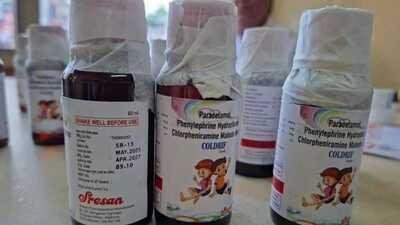At least 14 children in Chhindwara district of India's Madhya Pradesh died after consuming a cough syrup, which was later found to have a toxic contaminant diethylene glycol (DEG). The syrup called Coldrif syrup, manufactured by the Tamil Nadu-based Sresan Pharmaceuticals, was found to contain 46.28% DEG, against the acceptable limit of less than 0.1%.
What is DEG and how is it toxic?

Diethylene glycol and Ethylene Glycol are colourless, odourless liquids primarily used in industrial applications including antifreeze, brake fluids, solvents, paints and plastic. It is toxic to humans and poses a risk of damaging the kidneys, liver and nervous system.
When ingested, DEG is metabolised into the body in the form of toxic compounds that can cause acute kidney injury, anuria, and even death, as in the case of the children in Madhya Pradesh. Symptoms of this poisoning include vomiting abdominal pain, and lethargy, which often quickly lead to renal failure.
Various pharmaceutical syrups rely on glycerine or propylene glycol to dissolve the active ingredient. These solvents are safe for consumption.
However, some manufacturers substitute it with DEG to save money. In other cases, contamination occurs when industrial-grade glycerine or propylene glycol gets tainted with DEG.
DEG: A tale of tragedies

The World Health Organization (WHO) has often warned of cough syrups contaminated with DEG and EG. The organization has linked them to over 300 child deaths worldwide since 2022.
The deaths in India aren't the first or the only case. In 2022, 70 children in The Gambia died after consuming cough syrups contaminated with DEG. In 2008-2009 Nigeria experienced a similar tragedy when 57 children died after consuming a teething syrup contaminated with DEG. And in 1937, 105 Americans died after drinking a DEG-tainted sulphanilamide solution.
What is DEG and how is it toxic?
Diethylene glycol and Ethylene Glycol are colourless, odourless liquids primarily used in industrial applications including antifreeze, brake fluids, solvents, paints and plastic. It is toxic to humans and poses a risk of damaging the kidneys, liver and nervous system.
When ingested, DEG is metabolised into the body in the form of toxic compounds that can cause acute kidney injury, anuria, and even death, as in the case of the children in Madhya Pradesh. Symptoms of this poisoning include vomiting abdominal pain, and lethargy, which often quickly lead to renal failure.
Various pharmaceutical syrups rely on glycerine or propylene glycol to dissolve the active ingredient. These solvents are safe for consumption.
However, some manufacturers substitute it with DEG to save money. In other cases, contamination occurs when industrial-grade glycerine or propylene glycol gets tainted with DEG.
DEG: A tale of tragedies
The World Health Organization (WHO) has often warned of cough syrups contaminated with DEG and EG. The organization has linked them to over 300 child deaths worldwide since 2022.
The deaths in India aren't the first or the only case. In 2022, 70 children in The Gambia died after consuming cough syrups contaminated with DEG. In 2008-2009 Nigeria experienced a similar tragedy when 57 children died after consuming a teething syrup contaminated with DEG. And in 1937, 105 Americans died after drinking a DEG-tainted sulphanilamide solution.
You may also like

Nandish Sandhu Engagement: After Rashmi Desai, Nandish fell in love with this beauty, got engaged and announced the good news

Delhi Waqf Board PMLA case: ED files Prosecution sanction against AAP MLA Amanat Ullah Khan

Brit businessman, 50, dies in horror Thailand crash as he's hit by three cars

Kafka, chaos and the "Master of Apocalypse": The world of Laszlo Krasznahorkai

POLL: Should Prince Harry and Meghan Markle make more trips to Europe?






